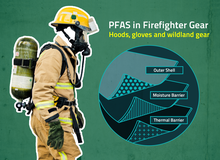Staff Spotlight
March 10, 2025
The Flammability Reduction Group within the Fire Research Division (FRD) welcomes Dr. Brittany Stinger to the National Institute of Standards and Technology (NIST) as a National Research Council (NRC) Postdoctoral Fellow

We are thrilled to welcome Dr. Brittany Stinger to NIST. Dr. Stinger will collaborate with Dr. Rick Davis and the PFAS project team on the Public Health Risks to First Responders project, as well as other projects within FRD.
HIGHLIGHT
December 2024
PFAS Found in Firefighter Gloves, Hoods and Wildland Gear

The protective clothing worn by wildland firefighters often contains PFAS, according to a new study from the National Institute of Standards and Technology (NIST). The study also found PFAS in hoods and gloves worn by firefighters who respond to building fires.
READ MORE













